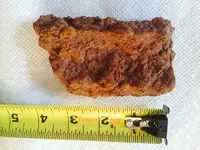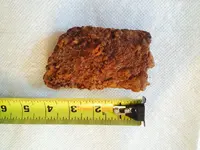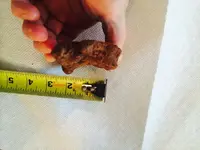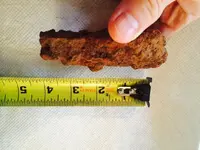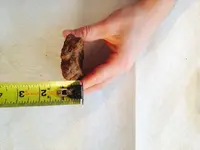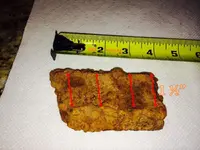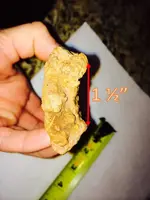First... thank you for providing the info about all of the types of cannons which were present at that battlesite. Most were Smoothbore cannons, which fire cannon balls. Apparently, the only cannons which were present there that used cylindrical shells were 2.9"-caliber ("10-Pounder) Parrott rifled cannons. Their projectiles at that time (October 1861) were about 2.85 inches in diameter.
It's difficult to explain how I calculated your the diameter of the exploded CYLINDRICAL artillery shell in written words. If you and I were in the same room together talking, I could point with my fingers and quickly draw a picture which would explain everything quickly and easily. But unfortunately, I cannot draw a picture on the computer, so I'll have to try to draw one with written words.
Look at the photo (which you marked with 1-&-1/2-inches) in your post just above this one. Your fragment is a bit less than 1/4th of a circle. To calculate the diameter of that circle (which would be the diameter of the cylindrical shell's body), we must precisely draw the rest of the circle.
Imagine that your fragment's curved edge is part of the rim of a clock. Envision your fragment's curved edge as being the part of the clock-rim which goes from 12 o'clock to 3 o'clock. Imagine that you had another fragment of that shell, which goes from 3 to 6 o'clock. Put the two frags together to make a half-circle. Measure the distance from the connected fragments' OUTSIDE at 12 to the outside at 6 o'clock. That gives you the diameter of the cylindrical shell's body.
Using that method, with the size-measurements you've provided, indicates the diameter of the cylindrical shell your fragment came from is larger than a 10-Pounder shell's 2.85" diameter. The next-bigger size OF PARROTT PROJECTLE above the "10-Pounder" size is the "20-Pounder" Parrott projectile, which is 3.60-inches in diameter... so that's what I guessed your fragment is from. But there seems to be no record of the next-bigger size being present at that battle.
Apparently, something in the size-measurements is an incorrect estimate. The very thick rust-crust on your fragment may be affecting the size calculation. The only solution is to clean all the rust-crust off the outside of your fragment and re-do the calculation. As I indicated above, if you and I were together in the same room with the cleaned fragment, and I had a ruler or a Digital Caliper, the calculation could be re-done in less than a minute (and I could demonstrate exactly how it works). Perhaps we will get to do that someday, at a civil war relic show.
Until that can be done, I have to assume the size-estimate is incorrect, and your fragment is from a "10-Pounder" (2.85" diameter) Read-Parrott shell, because that is the only size of cylindrical-bodied shell known to have been used at the October 1861 Battle Of Ball's Bluff.
 ?
?
 ?
?



